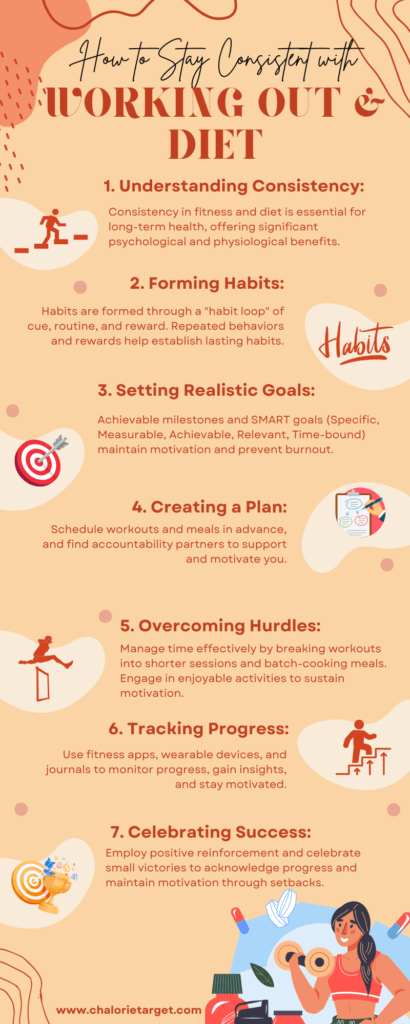Achieving peak fitness and maintaining a healthy diet are often touted as critical pillars of a long, healthy life. Yet, many individuals need help maintaining consistency in their fitness and dietary routines.
Whether it’s the lure of fast food, the comfort of a couch, or the sheer demands of a busy lifestyle, staying consistent can feel like an uphill battle. But here’s the good news: consistency is not about perfection—it’s about committing to your health and sticking with it through the ups and downs.
In this blog post, we’ll explore practical strategies for staying consistent with exercise and diet, backed by scientific research and expert insights.
1. The Science Behind Consistency
Consistency is more than just a buzzword. Research shows that regular physical activity and a balanced diet have profound psychological and physiological benefits.
For instance, a 2019 study published in The Lancet Psychiatry found that regular exercise was linked to improved mental health and reduced risk of depression.
Moreover, a stable diet rich in nutrients has been shown to enhance brain function, improve mood, and reduce the risk of chronic diseases.
Read More: How Many Calories Does Weight Lifting Burn? Debunking the Myths
a. How Habits Are Formed
Habits are formed through a “habit loop,” which involves a cue, a routine, and a reward.
Dr. Kelly McGonigal, a health psychologist and lecturer at Stanford University, explains, “To build a new habit, you need to find a cue that triggers the behavior, repeat the behavior consistently, and reward yourself to reinforce the habit.”
By understanding this loop, you can rewire your brain to form positive habits that stick.

2. Setting Realistic Goals
To stay consistent with working out and diet there are some important goals to be achieved which i will elaborate below:
a. Importance of Achievable Milestones
Setting realistic goals is crucial for maintaining motivation. Unrealistic goals can lead to burnout and failure, while achievable milestones provide a sense of accomplishment and encourage you to keep going.
According to a renowned fitness coach, Joe Wicks, “It’s important to set small, achievable goals that contribute to your larger objective. This way, you can celebrate small wins, which helps keep you motivated.”
b. SMART Goals
One effective method for goal-setting is the SMART criteria: Specific, Measurable, Achievable, Relevant, and Time-bound. For example, instead of saying, “I want to get fit,” a SMART goal would be, “I will run three times a week for 30 minutes each session for the next month.”
3. How to Create a Consistency Plan
a. Scheduling Workouts and Meals
Creating a structured plan can help you stay consistent. Schedule your workouts and meals in advance, just like any necessary appointment.
Kayla Itsines, a leading fitness influencer, suggests, “Plan your workouts and meals at the start of the week. Having a clear plan eliminates the decision-making process, making it easier to stick to your routine.”
b. Role of Accountability Partners
Accountability partners and communities can play a significant role in helping you stay on track. Joining a fitness group or having a workout buddy can give you the support and motivation you need. Studies have shown that social support significantly increases adherence to exercise programs.
Read More: What is the Difference Between Keto and Carnivore Diet?
4. How to Overcome Common Hurdles
a. Lack of Time
Lack of time is one of the most common reasons people give up on their fitness and diet goals. However, effective time management can help you carve out time for these essential activities. Try breaking your workouts into shorter sessions throughout the day or batch-cooking meals over the weekend.
b. Lack of Motivation
Motivation can ebb and flow, but understanding its psychology can help you stay consistent. Intrinsic motivation—doing something because you enjoy it or find it fulfilling—is more sustainable than extrinsic motivation, which relies on external rewards. Find activities you love and make them a part of your routine.
5. How to Adapt to Change
Life is unpredictable, and being flexible in your approach can lead to satisfaction. Learn to adapt your consistency plan for vacations, busy periods, or changes in routine.
Flexibility doesn’t mean giving up on your goals; it means finding a way to keep moving forward, even if the path looks different than expected.
6. How to Track Progress
a. Benefits of Monitoring Progress
Tracking your progress can provide valuable insights into what’s working and needs adjustment. It also offers a sense of accomplishment and keeps you motivated. Various tools and methods, such as fitness apps, journals, and wearable devices, can help you monitor your fitness and dietary progress.
b. Tools and Methods
- Fitness Apps: Apps like MyFitnessPal and Strava can help you log workouts and meals and track your progress and overall health and fitness.
- Wearable Devices: Fitness trackers like Fitbit and Apple Watch can monitor your activity levels, workout routines, heart rate, and more.
- Journals: Keeping a fitness level and diet journal allows you to reflect on your journey and make necessary adjustments.
Read More: Is it Possible to Build Muscle in a Calorie Deficit?
7. Tip for Consistent Exercise
a. Prioritize Enjoyable Activities
Consistency becomes much easier when you engage in activities that you genuinely enjoy. Whether it’s dancing, hiking, cycling, or playing a sport, finding an exercise that you love can make it feel less like a chore and more like a fun part of your daily routine.
According to a study published in the Journal of Happiness Studies, people who engaged in enjoyable physical activities reported higher levels of happiness and well-being compared to those who did not enjoy their workouts.
b. Start Small
Especially if you’re new to regular exercise, starting small can prevent burnout and injury. Begin with manageable workout sessions, such as a 10-minute walk or a brief yoga routine, and gradually increase the intensity and duration. Starting small helps you build confidence and develop a habit without overwhelming yourself.
c. Mix It Up
Variety is the spice of life, and it also applies to your fitness routine. Mixing up your workouts keeps you mentally engaged and can prevent physical plateaus where your body adapts to a specific exercise, reducing its effectiveness over time.
Incorporate a blend of cardio, strength training, and flexibility exercises to keep things exciting and work for different muscle groups.
d. Set a Routine
A consistent schedule can significantly increase the likelihood of sticking to your exercise plan. Determine the best time for your workouts plan—morning, afternoon, or evening—and make it a non-negotiable part of your day. Establishing a routine helps form a lasting habit and makes exercise a regular aspect of your life.
e. Utilize Short Workouts
Short, intense workouts like High-Intensity Interval Training (HIIT) can be highly effective for those with tight schedules. HIIT workouts, typically 15 to 30 minutes, offer the benefits of longer workouts in a shorter period by alternating between intense bursts of activity and short rest periods.
f. Track Your Results
Monitoring your progress not only provides motivation but also helps you stay accountable. Use tools like fitness apps, journals, or wearables to track your workouts and measure strength, endurance, and overall fitness improvements. Seeing tangible progress can reaffirm your commitment to your exercise regimen.
g. Be Kind to Yourself
Lastly, being kind to yourself throughout your fitness journey is crucial. Everyone has days when they feel unmotivated or miss a workout. Instead of dwelling on these moments, focus on what you have accomplished and how far you’ve come.
A setback is just a setup for a comeback; maintaining a positive mindset will help you overcome obstacles.
8. How to Be Consistent With Your Diet
a. Understanding Hunger Cues
Listening to your body’s hunger and fullness signals is fundamental to mindful eating. Recognize the difference between physical hunger and emotional cravings, and aim to nourish your body with healthy, satisfying foods. This practice can prevent overeating and promote a balanced relationship with food.
b. Meal Prepping
Meal prepping can be a game-changer in maintaining a consistent diet. By preparing your meals in advance, you can ensure that you always have nutritious options and have health benefits.
This reduces the temptation to opt for fast food or unhealthy snacks. Plan your weekly meals, cook in bulk, and store portions in the fridge or freezer for quick access.
c. Balanced Diet
Aim for a balanced diet rich in whole foods, including fruits, vegetables, whole grains, lean proteins, and healthy fats. Avoid highly processed foods and sugary snacks, as they can lead to energy crashes and hinder your progress.
By focusing on nutrient-dense options, you’ll feel more satisfied and energized throughout the day.
d. Hydration
Staying hydrated is an often overlooked but vital component of a healthy diet. Proper hydration aids digestion, keeps you energized, and can even help control hunger.
Aim to drink at least eight glasses of water daily, and more if you’re active. Carry a water bottle to ensure you stay hydrated throughout the day.
e. Mindful Eating Techniques
Practice mindful eating by paying full attention to your meals. Eat slowly, savor each bite, and avoid distractions like TV or phones during meals. This approach can enhance your enjoyment of food, improve digestion, and help you better recognize your body’s hunger and fullness signals.
9. Celebrating Success and Staying Motivated
a. Positive Reinforcement
Positive reinforcement and reward systems play a crucial role in maintaining consistency. Celebrate your achievements, big or small, to stay motivated.
This could be treating yourself to a new workout outfit, indulging in a favorite healthy snack, or simply taking a moment to acknowledge your progress.
b. Staying Motivated
Recognition of your achievements and understanding that setbacks are part of the journey can motivate you. Reflect on how far you’ve come and use that as fuel to keep going.
As Kayla Itsines puts it, “Celebrate every victory, no matter how small. Progress is progress.”
10. Conclusion
Staying consistent with your working out and diet is a journey that requires commitment, flexibility, and a positive mindset. By understanding the science behind consistency, setting realistic goals, creating a structured plan, overcoming common hurdles, adapting to change, tracking your progress, and celebrating your successes, you can build long-term healthy habits that last.
Remember, consistency is not about being perfect—it’s about committing to your health and sticking with it through the ups and downs.
